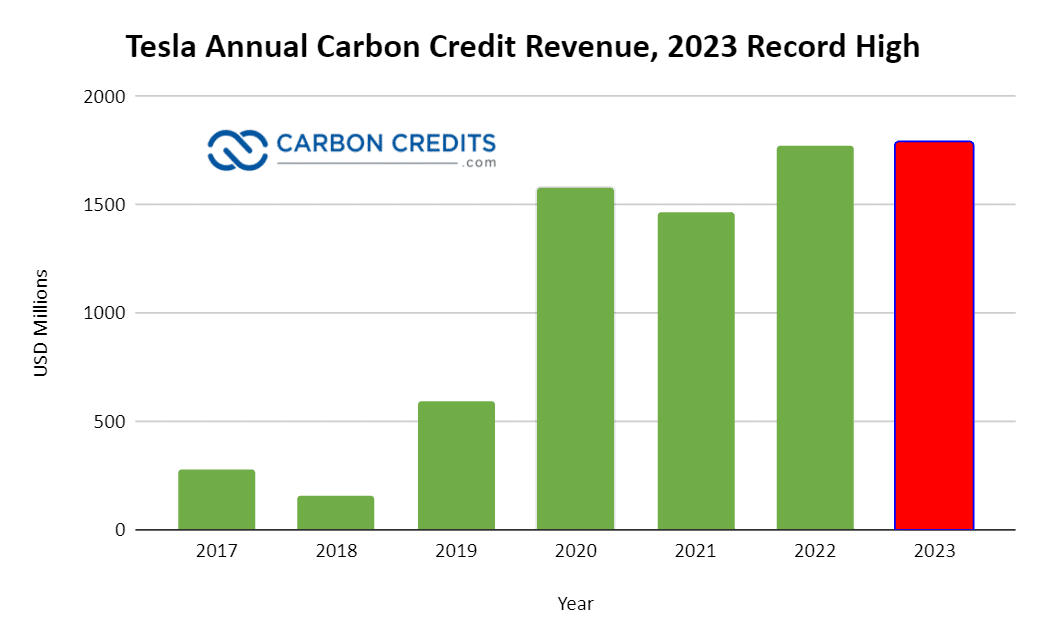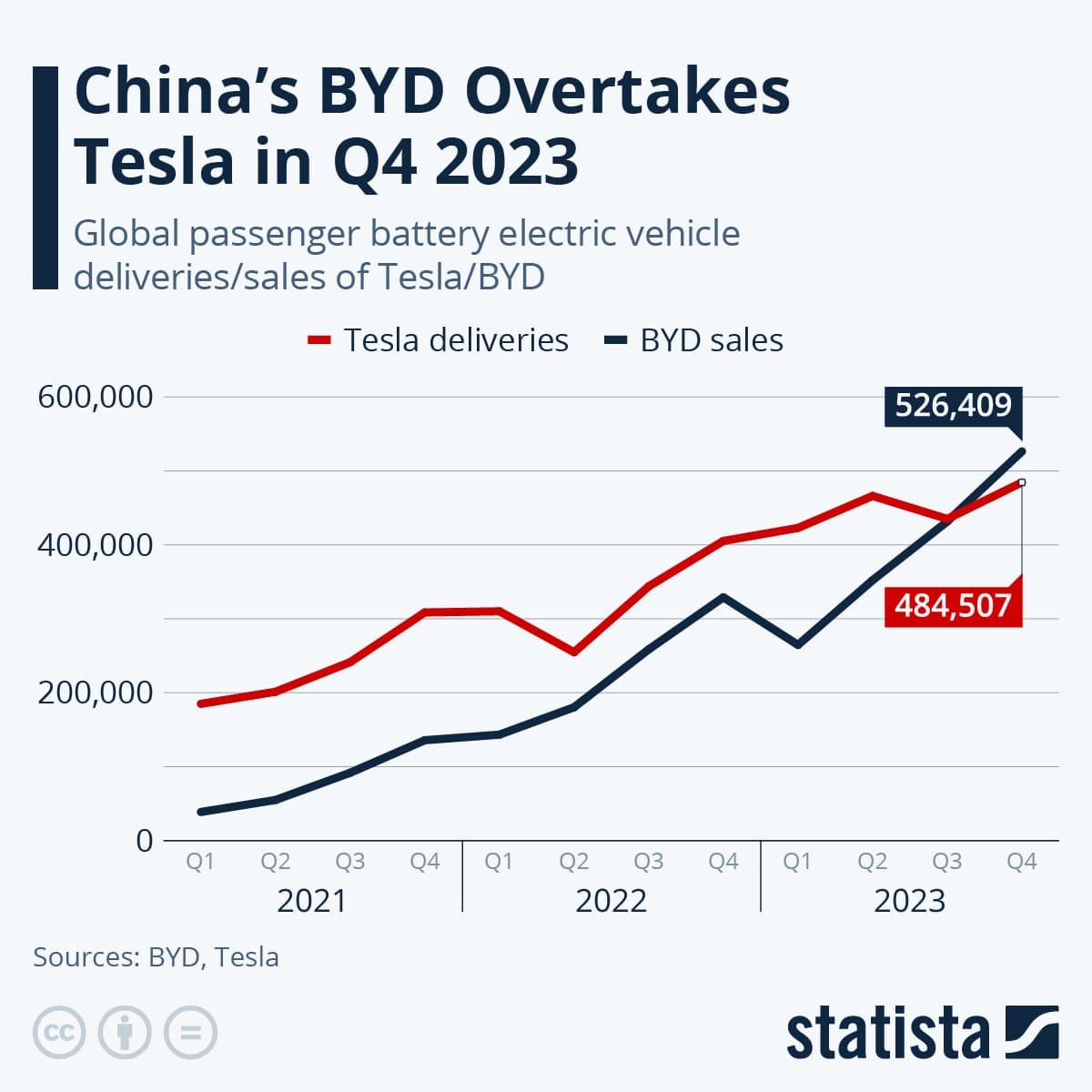Elon Musk’s Tesla generated a substantial $1.79 billion from carbon credit sales last year, as revealed in their Q4 2023 and annual financial report, bringing its total earnings from such credits since 2009 to nearly $9 billion.
This revenue comes from trading regulatory credits to other automakers unable to meet emission regulations in the US, Europe, and China.
Carbon Credit Cashflow: Tesla’s Billion-Dollar Bonanza
Tesla continues to profit from the need of its rivals to meet emissions standards. It is a lucrative business that was initially expected to diminish. Since the EV giant incurs minimal additional costs to earn these credits, the sales represent almost pure profit.
This revenue stream has been crucial for Tesla, although the specific recipients of the credits remain undisclosed.
In its recent fourth quarter and annual 2023 filings, the EV maker reported a $433 million income from the sale of carbon credits. That figure represents a 7% decrease year over year (YoY) compared to $467 million earned in Q4 2023.
But the total annual revenue of Tesla from selling carbon credits in 2023 increased to $1.79 billion from $1.78 billion. Yet, that enabled the automaker to reach another record high in 2023.

 This sustained revenue may have surprised Tesla, given previous expectations that regulatory credit income would fall as competitors increased EV production.
This sustained revenue may have surprised Tesla, given previous expectations that regulatory credit income would fall as competitors increased EV production.
In 2020, the company’s former CFO Zachary Kirkhorn cautioned investors about relying too heavily on this revenue stream. He forecasted a decline in its significance over time.
However, contrary to expectations, Tesla’s earnings from regulatory carbon credits have not decreased significantly, as last year’s earnings slightly surpassed the previous year’s income.
Tesla is Driving the Carbon Market Forward
By providing its peers a mechanism to offset their carbon emissions, Tesla plays a significant role in the carbon credit market.
As the automotive sector seeks to comply with emissions standards set by regulatory bodies, they can purchase carbon credits from Tesla. They can also do the same from other companies that reduce greenhouse gas emissions through renewable energy and other carbon reduction or removal initiatives.
The revenue generated from the sale of carbon credits has become a substantial source of income for the company. In fact, the credits account for a staggering 11% of Tesla’s overall gross margin for the quarter, $4,065 million, down from 25.9% seen in Q4 2022.
Tesla’s total automotive revenues of $21,563 million were up 1% YoY but missed analysts’ estimate of $22,385 million.
Still, the growing carbon credit sales underscores the value of the EV maker’s clean energy initiatives. This is also evidenced by another growing business of the company, energy generation and storage. Its Q4 2023 revenues totaled more than $1.4 million, up from the year-ago earning of $1.3 million.
Given the global focus on reducing carbon emissions and addressing climate change, the demand for carbon credits is expected to increase in the future.
Tesla’s position as a leader in the electric vehicle market and its commitment to sustainable energy place it in a favorable position to continue profiting from the sale of carbon credits in the years to come.
Gearing Up Amid Shifting Automotive Landscape
Despite its continued dominance in the U.S. EV market, Tesla faces growing competition, particularly from China’s BYD. The Chinese automaker recently surpassed Tesla as the world’s largest seller of EVs.


BYD’s vehicle production was up substantially last year, almost 2x as high as in 2022, at 3.02 million units. However, around 1.4 million of these vehicles were hybrids, while Tesla produced around 1.84 million all-electric vehicles.
Moreover, some of Tesla’s competitors are scaling back their EV investment plans, with Ford delaying $12 billion in investments. On the other hand, General Motors is reintroducing hybrids to its lineup.
As emissions regulations tighten, the regulatory landscape becomes increasingly challenging.
Europe is imposing stricter car emissions targets starting next year, with even more stringent standards set for 2030 and beyond. The EU sets a 100% emission reduction goal for both cars and vans from 2035 onwards.
Similarly, the United Kingdom has implemented a zero-emission vehicle mandate beginning this year.
At home in the U.S., the government committed $623 million in grants to propel the growth of EVs. The financing was made available through the 2021 Bipartisan Infrastructure Law. The funding aims to make EV chargers more reliable and accessible for American drivers.
Tesla’s lucrative carbon credit sales continue to defy expectations, bolstering its financial performance and solidifying its role in sustainable transportation. And despite growing competition and tightening emissions regulations, Tesla’s position in the EV sector remains robust, fueled by its commitment to clean energy initiatives.
- SEO Powered Content & PR Distribution. Get Amplified Today.
- PlatoData.Network Vertical Generative Ai. Empower Yourself. Access Here.
- PlatoAiStream. Web3 Intelligence. Knowledge Amplified. Access Here.
- PlatoESG. Carbon, CleanTech, Energy, Environment, Solar, Waste Management. Access Here.
- PlatoHealth. Biotech and Clinical Trials Intelligence. Access Here.
- Source: https://carboncredits.com/tesla-hits-record-high-sales-from-carbon-credits-at-1-79b/



